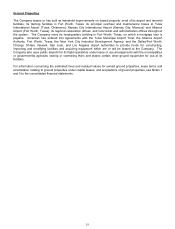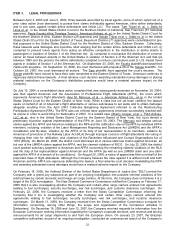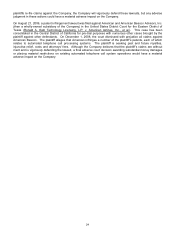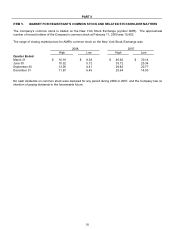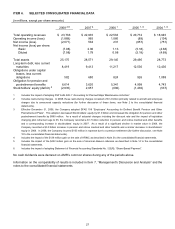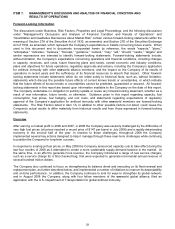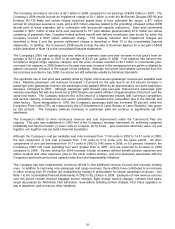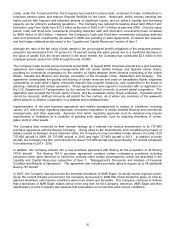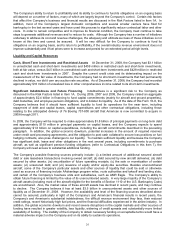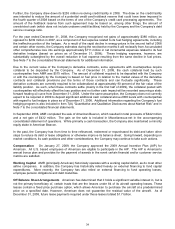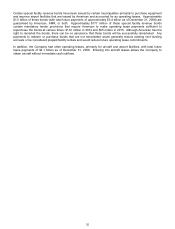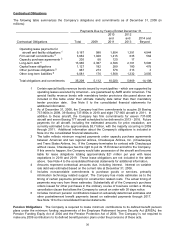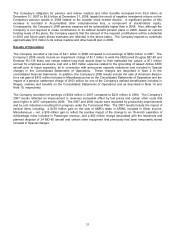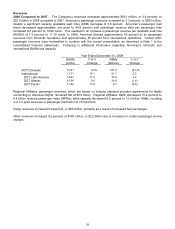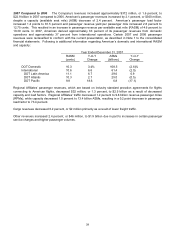American Airlines 2008 Annual Report Download - page 34
Download and view the complete annual report
Please find page 34 of the 2008 American Airlines annual report below. You can navigate through the pages in the report by either clicking on the pages listed below, or by using the keyword search tool below to find specific information within the annual report.
31
The Company’s ability to return to profitability and its ability to continue to fund its obligations on an ongoing basis
will depend on a number of factors, many of which are largely beyond the Company’s control. Certain risk factors
that affect the Company’s business and financial results are discussed in the Risk Factors listed in Item 1A. In
addition, most of the Company’s largest domestic competitors and several smaller carriers have filed for
bankruptcy in the last several years and have used this process to significantly reduce contractual labor and other
costs. In order to remain competitive and to improve its financial condition, the Company must continue to take
steps to generate additional revenues and to reduce its costs. Although the Company has a number of initiatives
underway to address its cost and revenue challenges, the adequacy and ultimate success of these initiatives is not
known at this time and cannot be assured. It will be very difficult for the Company to continue to fund its
obligations on an ongoing basis, and to return to profitability, if the overall industry revenue environment does not
improve substantially and if fuel prices were to increase and persist for an extended period at high levels.
Liquidity and Capital Resources
Cash, Short-Term Investments and Restricted Assets At December 31, 2008, the Company had $3.1 billion
in unrestricted cash and short-term investments and $459 million in restricted cash and short-term investments,
both at fair value, versus $4.5 billion in unrestricted cash and short-term investments and $428 million in restricted
cash and short-term investments in 2007. Despite the current credit crisis and its deteriorating impact on the
measurement of the fair value of investments, the Company had no short-term investments that had permanently
declined in value, nor did it own any auction rate securities. As of December 31, 2008, the Company had recorded
approximately $10 million of unrealized loss in other comprehensive income related to its short-term investments.
Significant Indebtedness and Future Financing Indebtedness is a significant risk to the Company as
discussed in the Risk Factors listed in Item 1A. During 2006, 2007 and 2008, the Company raised an aggregate
of approximately $2.4 billion in financing to fund capital commitments (mainly for aircraft and ground properties),
debt maturities, and employee pension obligations, and to bolster its liquidity. As of the date of this Form 10-K, the
Company believes that it should have sufficient liquidity to fund its operations for the near term, including
repayment of debt and capital leases, capital expenditures and other contractual obligations, including those
relating to the anticipated delivery of 76 Boeing 737-800 aircraft that American is now committed to acquire in
2009 through 2011.
In 2009, the Company will be required to make approximately $1.8 billion of principal payments on long-term debt
and approximately $110 million in principal payments on capital leases, and the Company expects to spend
approximately $1.6 billion on capital expenditures, including the aircraft commitments described in the preceding
paragraph. In addition, the global economic downturn, potential increases in the amount of required reserves
under credit card processing agreements, and the obligation to post cash collateral to secure loss positions on fuel
hedging contracts, also pose challenges to our liquidity. To maintain sufficient liquidity and because the Company
has significant debt, lease and other obligations in the next several years, including commitments to purchase
aircraft, as well as significant pension funding obligations (refer to Contractual Obligations in this Item 7), the
Company will need access to substantial additional funding.
The Company’s possible financing sources primarily include: (i) a limited amount of additional secured aircraft
debt or sale leaseback transactions involving owned aircraft; (ii) debt secured by new aircraft deliveries; (iii) debt
secured by other assets; (iv) securitization of future operating receipts; (v) the sale or monetization of certain
assets; (vi) unsecured debt; and (vii) issuance of equity and/or equity-like securities. Besides unencumbered
aircraft, some of the Company’s particular assets and other sources of liquidity that could be sold or otherwise
used as sources of financing include AAdvantage program miles, route authorities and takeoff and landing slots,
and certain of the Company’s business units and subsidiaries, such as AMR Eagle. The Company’s ability to
obtain future financing is limited by the value of its unencumbered assets. A very large majority of the Company’s
aircraft assets (including most of the aircraft eligible for the benefits of Section 1110 of the U.S. Bankruptcy Code)
are encumbered. Also, the market value of these aircraft assets has declined in recent years, and may continue
to decline. The Company believes it has at least $3.5 billion in unencumbered assets and other sources of
liquidity as of December 31, 2008. However, the availability and level of the financing sources described above
cannot be assured, particularly in light of the Company’s and American’s financial results in recent years, the
Company’s and American’s substantial indebtedness, the difficult revenue environment they face, their reduced
credit ratings, recent historically high fuel prices, and the financial difficulties experienced in the airline industry. In
addition, the global economic downturn and recent severe disruptions in the capital markets and other sources of
funding have resulted in greater volatility, less liquidity, widening of credit spreads and substantially more limited
availability of funding. The inability of the Company to obtain necessary funding on acceptable terms would have a
material adverse impact on the Company and on its ability to sustain its operations.


